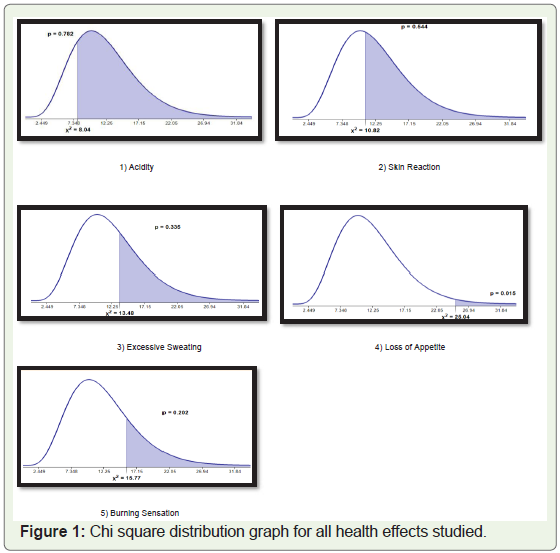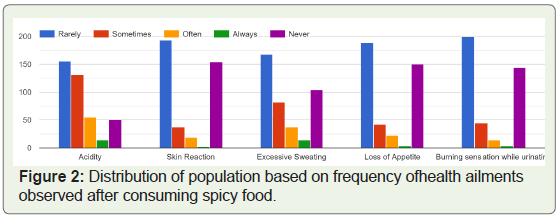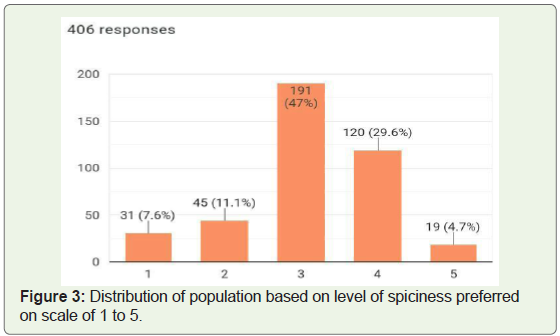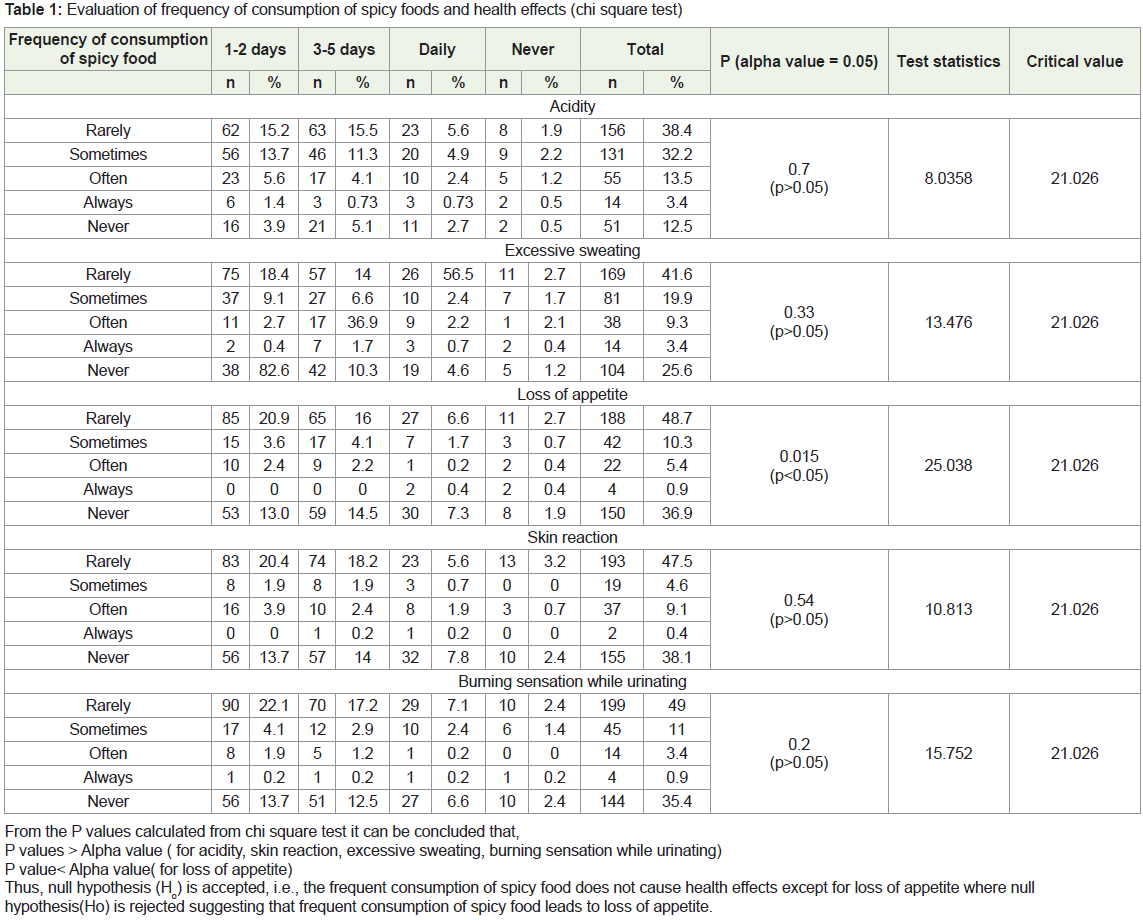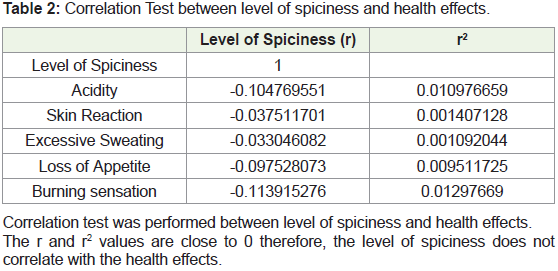Research Article
Effect of Spicy Diet on Health: A Comprehensive Study
Rajkotiya NH1, Sawant SU1* and Deepak S2
1Jai Hind College, Mumbai, India
2Department of Microbiology, Jai Hind College, Mumbai, India
*Corresponding author: Sawant SU, Jai Hind College, Mumbai, India Email: sanskarsawant2000@gmail.com
Article Information: Submission: 25/01/2023; Accepted: 27/02/2023; Published: 03/03/2023
Copyright: © 2023 Rajkotiya NH, et al. This is an open access article distributed under the Creative Commons Attribution
License, which permits unrestricted use, distribution, and reproduction in any medium, provided the original work is properly
cited.
Abstract
Spices have been an integral part of cooking since ancient times and are widely used as flavouring and colouring agents around the world. The active
component that gives spicy food its hot tangy flavour is capsaicin.
Capsaicin provides many health benefits and therefore, is now also introduced in medical, cosmetic and perfume industry. Asians consume more spicy
food compared to western countries. Some people frequently savour spicy food while others try and avoid it, because a lot of people believe that frequent
consumption of spicy food causes common health effects such as acidity, loss of appetite, excessive sweating, skin reaction and burning sensation while
urinating. The purpose of this study was to investigate the relationship between frequent consumption of spicy food and health effects. A survey-based study
was conducted to determine the frequency of spicy food intake, preferences and other general characteristics. Based on the data collected, chi-square and
correlation tests were performed on the selected health ailments. Maximum population (47%) preferred moderate level of spiciness and only 4.7% preferred
extreme level of spiciness. No correlation was found between level of spiciness and health effects. These findings suggest that consuming spicy food is not
the sole reason for health effects.
Keywords
Spicy diet; Capsaicin; Health effects; Statistical analysis; Chi-square test; Correlation test
Introduction
Spice is a crushed powder of fruit, bark, root, or seed of specific
plants and is used since long time as a flavoring and coloring agent.
Other components commonly used as flavoring agents are herbs.
Spices can be distinguished from herbs, as herbs are extracted from
leaves, flowers or stems of plants. Spices have been used as color
and flavoring agents, for preservation, and medical purpose in
many ancient cultures around the world [1]. Now-a-days, perfume,
cosmetic and pharmaceutical industries have also started including
spices in their products.
On an average, Asian people consume 2.5-8 g chili per day, versus
~ 0.1-0.5 g per day by Europeans and Americans [2]. This indicates the
high amount of spice used in Asian cuisines as compared to western
countries. The active component in spicy food that provide its tangy flavour is capsaicin. There are various health benefits of spicy foods.
The component capsaicin is believed to keep the weight in checkof
an individual [3]. It is believed that consuming spicy food increases
longevity and body metabolism of an individual, reduces digestive
issues, relieves diarrhoea and eases health issues related to heart [4-6].
Spices can relieve arthritic and neurotic pain of an individual and
may also be used as an analgesic.[7] Spicy food is seen as a source of
endorphin for the people suffering from depression.[8]
Although consumption of spicy food has various health
benefits, still there is a common myth among people that frequent
consumption of spicy food causes common health ailments such as
acidity, excessive sweating, skin reactions, loss of appetite, burning
sensation on urinating, etc. Dietary recommendations for the
consumption of spicy foods and its effect on health are debatable.
Spicy foods have been consumed by humans for centuries.,
although the heat present in most plants is an adaptation meant to
be a consumption deterrent [9]. Many researchers have explored the
psychological and physiological reasons behind different preferences
towards spicy foods. When spicy food likers and spicy foods nonlikers
consumed spiked jelly with equal amount of capsaicin, nonlikers
rated the jelly to be more intense and less pleasant than likers.
The results of this study propose that genetic factors may also help
explain differences in pungency [10]. A finding mentioned in Jay M.
Lillywhite, 2013 suggests that exposure can develop likeness towards
spicy food [9],while other findings show no difference between‘‘nonlikers’’
and ‘‘likers’’ in their exposure to spicy foods [10]. Cultural
influences (e.g., role models, early introduction) may also affect
frequency of consumption of spicy foods [2].
Certain individuals develop preference for spicy foods, while
others reject them, this holds substantial merit in public health which
is explained and understood by improved potential mechanism. One
mechanism that may account for difference in spicy food preference
is that, experience may alter the sensory responses elicited by
spicy foods, leading to more favourable evaluations and increased
consumption frequency of spicy intake [2]. It is conceivable that
adaptations induced due to regular, repeated exposure, however
initiated, may allow individuals to more easily tolerate the pungency
of spicy foods and suffer less health effects [2].
Hedonic responses towards spicy foods are varied extraordinarily,
ranging from high desirability to aversions [2]. The frequency of
consumption of spicy food and customary concentration are equally
diverse, suggesting that sensation seekers require greater stimulation
from foods with respect to taste (flavour) and texture [2].
Earlier works from the 1970s and 1980 reported positive
correlations between sensation seeking behaviour and the
consumption of spicy foods [2]. The beneficial effects attributed to
chili peppers in extreme climates represent dynamic culture impact
on food choice [2]. The sweating induced by chili peppers is viewed
as a cooling mechanism in hot weather [2], whereas for some it is
considered as side effect of spicy food.
In humans, it is well established that repeated experience and
exposure with unfamiliar foods increases both liking and preference
[2] for those foods. The frequency of spicy food intake plays potential
role in likeness and preference towards it. Some people frequently
savour spicy food while others try and avoid it, because a lot of
people believe that frequent consumption of spicy foods cause health
effects. Therefore, a survey was conducted to evaluate the frequency
of spicy food consumption and its effect on health. The objective
was to statistically check whether the common health effects faced
by large population, like acidity, excessive sweating, skin reactions,
loss of appetite, burning sensation while urinating, etc are linked to
excessive spicy food consumption and put forward the facts related
to it.
Materials and Methods
Subject study:
The frequency of intake of spicy foods was estimated using a validated dietary habit questionnaire. The participants were chosen
from an urban demographic area. A survey was conducted and 406
responses of urban population were collected from different age
groups. The information collected was kept anonymous and clear
objectives were provided to the participants of the survey with regard
to the purpose of the study.Hedonic assessment of preferences:
The questionnaire for the survey was prepared using ‘Google
forms’ to determine general characteristic, spice habits of people and
their health status. The questionnaire was divided into three parts,
general information like age, weight, gender and physical activity was
included in the first part. In the second part, questions regarding their
use of spicy food, reasons for their preference, likeness towards spicy
food and frequency of spicy food intake were asked. In third part,
data related to medical history, their health status and health effects
experienced by consumption of spicy foods were collected.Statistical analysis:
The primary data obtained from the 406 responses was maintained
in Microsoft Excel (2018). The chi square test was applied to examine
the association between frequency of consumption of spicy food
and various health effects considering the standard alpha value to be
0.05. Correlation test was performed to evaluate the relation between
level of spiciness and health effects. The studied health effects were
supported with relevant graphs and distribution curves.Results and Discussion
Chi square test:
Chi square test was performed for the comparative study of the
parameters like frequency of consumption of spicy food, common
health effects observed after consumption of spicy food, and the
frequency of occurrence of health effects. The null hypothesis and the
alternate hypothesis are as follows:Ho = The frequent consumption of spicy food does not cause
health effects.
H1 = Frequent consumption of spicy food causes health effects.
The standard alpha value for the test was considered to be 0.05
The chi square test was performed for the health effects Acidity,
Skin reactions, Excessive sweating, Loss of appetite, Burning sensation
while urinating (Figure 1).
This large cross-sectional study explored the association between
spicy food consumption with health effects. The dataset obtained from
the responses of 406 candidates was examined and suitable statistical
tests were performed to extract valuable insights from the data.
Figure 2 shows the individual analysis of the frequency of
occurrence of each of the health ailments studied, which is also in
agreement with the results obtained from chi square test, since
graph of each of the respective health ailments depict the bar for the
response ‘rarely’, more than any other option mentioned.
Figure 2: Distribution of population based on frequency of health ailments
observed after consuming spicy food.
The fondness of spicy food and level of spicy food that population
prefers is represented in (Figure 3). According to this data, the extreme level of spiciness is preferred by very less population (4.7%).
Maximum population (47%) reported that they prefer medium level
of spiciness in their food and 7.6% of population reported very low
level of spiciness. In agreement with previous studies, this may be due
to difference in their sensory perception and experience with spicy
food or due to different stimuli of oral lingual trigeminal innervation.
[2] Level of spiciness was correlated with health effects and the results
shown in Table 2 which indicate that level of spiciness consumed have
no relation with health effects. The “r” and “r2” values come close to zero for all the health effects studied thus indicating their low
dependency on spicy food consumption.
According to the data represented in table 1 for acidity, individuals
that consumed spicy food 1-2 days (15.2%) or 3-5 days (15.5%)
experienced acidity rarely. Whereas, only 3.4%individualssuffered
from acidity every time they consumed spicy food. Maximum
population (38.4%) rarely suffered from acidity irrespective of
frequency of consumption of spicy food. This shows that experiencing
acidity is independent of frequency of spicy food consumption. Most
previous population-based studies showed similar results. In a study
conducted in 2019, by S. Rajaie the frequency or severity of heartburn
was not significantly associated with spicy food consumption among
women [11]. Similar results were obtained in a population based
Australian study [12].
The data in Table 1 illustrates the results for loss of appetite. As
much as 20.9% of the population consuming spicy food 1-2 days have
rarely experienced loss of appetite after consumption of spicy food.
Among total population, 48.7% rarely experience loss of appetite,
0.9% have always experienced and 36.9%have never experienced loss
of appetite irrespective of frequency of consumption of spicy food.
The chi square test suggests that frequent consumption of spicy
food causes loss of appetite as p<0.05. Therefore, null hypothesis is
accepted. In earlier study conducted in 2012 by S. Whiting, it was
observed that regular consumption of spicy food significantly reduced
adipose tissue level and showed reduction in appetite as well as energy
intake [13]. Consumption of spicy food has been shown to cause an
increase in gut derived hormone, which may be affecting hunger [13].
It may be that the release of catecholamine’s caused by capsaicin, is
influencing appetite [13]. It was also observed that there was less of
an effect on appetite amongst those that were consuming capsaicin
prior to the trial [13]. It is possible that Capsaicin have synergistic
effect with bioactive ingredients [13]. For example: the combined
effect of Capsaicin and green tea supplement reduced appetite and
energy uptake [13]. However, spicy food could play a role in reduced
appetite but is not the sole reason for loss of appetite.
The distribution of participants in terms of frequency of
consumption of spicy food and skin reaction is shown in Table 1.
Maximum population i.e.,47.5% have experienced skin reaction
rarely, whereas 38.1% have never experienced it. This suggests that
there is no correlation between spicy food intake and skin reaction.
But in an article published by marquee medicalin 2017they had
referred an outcome from Eastern Mediterranean Health Journal,
2006 which concluded that acidic content in spicy food alters skin
pH levels that triggers inflammatory reactions causing irritation
and breakouts on your skin [14]. Spicy foods are not stimulating
for everyone. Some people are sensitive to such foods because they
cause inflammatory chemicals in their bodies to dilate, allowing the
blood vessels in their skin to flush and turn red [15]. This could be the
reason why only 0.4% of the population has experienced skin reaction
every time they consumed spicy food.
The statistical data analysis for excessive sweating in Table 1 shows
that, 82.6% of population consuming spicy food for 1-2 days has
never experienced excessive sweating. As much as 56.5% of individual population have rarely experienced excessive sweating even though
they consumed spicy foods daily, whereas, population consuming
spicy food for 3-5 days (36.9%) have experienced it often. Among the
sample population, 22.1% of people consuming spicy foods for 1-2
days rarely experienced burning sensation while urinating, while 4.1%
experienced it sometimes. Whereas,6.6% of population have never
experienced it even though they consume spicy food daily. These results suggest that experiencing sweating and burning sensation
while urinating has no relation with spicy food intake. No previous
trials or studies were found that investigated the association between
spicy food consumption, excessive sweating and burning sensation.
Further investigation in this area would provide useful insights
which would help in drawing solid conclusions. Also, the chi square
distribution graphs shown in fig (a) obtained from statsdistribution.
com are in sync with the chi square test results.
Overall, it was seen that there is no significant statistical association
between frequency of consumption of spicy food and health effects
except for loss of appetite where association was observed between
consumption of spicy food and reduced appetite.
In earlier studies, conducted by Qiaorui Wenet al in year 2020,
it was found that metrics of spicy food consumption including
frequency and pungency degree, have been grouped with diverse
factors, including tea/alcohol consumption, tobacco, smoking and
different dietary habits. In addition, details of lifestyle vary across
frequency of consumption of spicy food and pungency degree which affect health outcome in different ways [5]. These earlier results
propose that the changing potency of other dietary habits, tea/alcohol
consumption and smoking as well as the patterns of these behaviours
must be taken into consideration while assessing the health effects of
spicy food consumption. Besides, our study didn’t take into account
the amount of spicy food intake and way of cooking. This would have
made the study more complete.
Conclusion
The present findings suggest that maximum population prefer
medium level of spiciness in their food and there is no correlation
between level of spiciness consumed and health effects. No statically
significant relation was found between frequency of spicy food intake
and health effects except for loss of appetite. Although there is no
direct relation between them but there are chances that if combined
with other dietary habits, smoking, tea/alcohol consumption, spicy
food scan cause adverse health effects.
Further, the study can be conducted in specific demographic
groups by considering various other factors such as age, gender,
health, diet, amount of physical activity, etc along-with amount of
spicy food intake and way of cooking while assessing health effects
along with frequency in order to conclusively say that spicy food
alone is not directly responsible for health effects.
Acknowledgement
This study was part of our course work in food production and
processing. We would like to thank the teachers of the Department of
Microbiology, Jai hind College, Mumbai who provided their guidance
and support during this study. Thanks to Dr.Piyali Unnikrishnan of
St. Xavier’s College, Statistics Department and Dr. Sonal Dasani of
Passion EdX Foundation for sharing their pearls of wisdom with us.
Also, thanks to Dr.Nissey Sunil of Jai Hind College for her valuable
comments. We would like to thank everyone who cooperated in the
survey for obtaining data.

